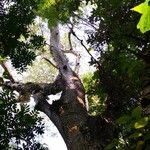Sarmentose shrub 1.5–5 m high or liana to 100 m long; deciduous; trunk with dark grey bark; branches dark brown or blackish, lenticellate; branchlets reddish brown, densely hispid; latex clear, reddish or white.. Leaves opposite or rarely ternate, petiolate, blade glossy green above, dull and paler beneath, ovate, elliptic or obovate, 3–15 cm long, 1.5–8 cm wide, base rounded or subcordate, apex acuminate, sparsely to densely hispid; petiole 1–5 mm long.. Inflorescence terminal or in forks, 1–72-flowered, sessile or pedunclate, lax or congested, hispid in all parts; pedicel 5–32 mm long.. Flowers with sepals unequal, the outer ovate, the inner linear, 13–35 mm long, acute; corolla tube white, turning yellow and then orange, red-to purple-spotted inside, 11–22 mm long, corolla lobes creamy turning orange, ovate, 3–10 mm long, 3–8 mm wide, narrowing into 15–23 cm long pendulous tails, these yellow, turning reddish distally, corona lobes yellow to purple-spotted, 1–3 mm long.. Fruit dark brown, hard, with mericarps opposite-divergent or at an obtuse angle, almost cylindrical, 24–48 cm long, long-tapering and abruptly widening into a terminal knob, lenticellate, sulcate and hispid to glabrescent; seed 10–18 mm long, with a stalked coma 5–12 cm long.
More
Lianas or stolon-bearing shrubs when cut, to 5 m tall, densely hispid; latex clear, reddish or white. Petiole 1-5 mm; leaf blade ovate to obovate, 3-22 X 1.5-12 cm, base rounded or subcordate; lateral veins 6-11 pairs. Cymes 3-72-flowered. Sepals ovate, inner ones often linear, 1.3-3.5 cm. Corolla yellow, tube 1-2.2 cm; lobes including tails 15-22.5 cm, proximal part ovate, tail pendulous, puberulent on both sides, to 1 mm wide; corona lobes yellow spotted with red, purple, or brown, tongue-shaped. Anthers included, glabrous. Ovary hispid. Style to 1.2 cm. Follicles very narrowly oblong, to 54 3 cm, densely lenticellate. Seeds narrowly ellipsoid, beak 2.3-7.7 cm, coma to 5 cm. Fl. Feb-Apr, fr. Jun-Dec. 2n = 18.
A shrub or creeper. It has runners or stolons. It can grow 5 m tall. The leaves are 3-22 cm long by 1.5-12 cm wide. The base is rounded or almost heart shaped. There are between 3-72 flowers in a group. They are yellow. The fruit is woody and 30-45 cm long and 1.3 cm wide.
Long-caudate white flowers turning to yellow, spotted red or brown inside
Fruit woody, 12-18 in. long and about 1/2 in. thick.
A coarsely hairy climbing shrub
Primary and secondary moist forest, or in woodland on rocky outcrops or in thickets, at elevations from sea-level up to 1,600 metres.


